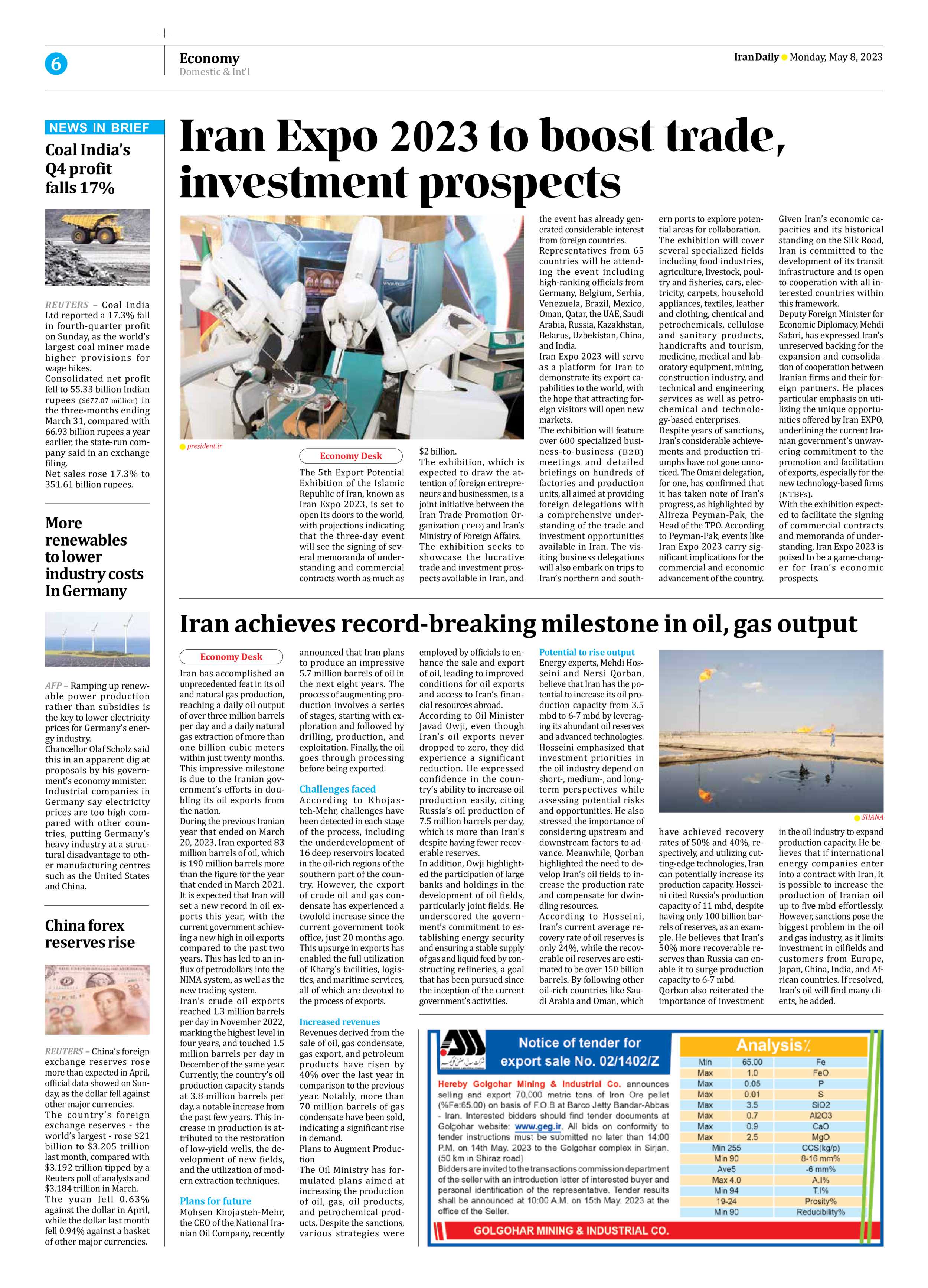
Iran achieves record-breaking milestone in oil, gas output
Iran has accomplished an unprecedented feat in its oil and natural gas production, reaching a daily oil output of over three million barrels per day and a daily natural gas extraction of more than one billion cubic meters within just twenty months. This impressive milestone is due to the Iranian government’s efforts in doubling its oil exports from the nation.
During the previous Iranian year that ended on March 20, 2023, Iran exported 83 million barrels of oil, which is 190 million barrels more than the figure for the year that ended in March 2021. It is expected that Iran will set a new record in oil exports this year, with the current government achieving a new high in oil exports compared to the past two years. This has led to an influx of petrodollars into the NIMA system, as well as the new trading system.
Iran’s crude oil exports reached 1.3 million barrels per day in November 2022, marking the highest level in four years, and touched 1.5 million barrels per day in December of the same year. Currently, the country’s oil production capacity stands at 3.8 million barrels per day, a notable increase from the past few years. This increase in production is attributed to the restoration of low-yield wells, the development of new fields, and the utilization of modern extraction techniques.
Plans for future
Mohsen Khojasteh-Mehr, the CEO of the National Iranian Oil Company, recently announced that Iran plans to produce an impressive 5.7 million barrels of oil in the next eight years. The process of augmenting production involves a series of stages, starting with exploration and followed by drilling, production, and exploitation. Finally, the oil goes through processing before being exported.
Challenges faced
According to Khojasteh-Mehr, challenges have been detected in each stage of the process, including the underdevelopment of 16 deep reservoirs located in the oil-rich regions of the southern part of the country. However, the export of crude oil and gas condensate has experienced a twofold increase since the current government took office, just 20 months ago. This upsurge in exports has enabled the full utilization of Kharg’s facilities, logistics, and maritime services, all of which are devoted to the process of exports.
Increased revenues
Revenues derived from the sale of oil, gas condensate, gas export, and petroleum products have risen by 40% over the last year in comparison to the previous year. Notably, more than 70 million barrels of gas condensate have been sold, indicating a significant rise in demand.
Plans to Augment Production
The Oil Ministry has formulated plans aimed at increasing the production of oil, gas, oil products, and petrochemical products. Despite the sanctions, various strategies were employed by officials to enhance the sale and export of oil, leading to improved conditions for oil exports and access to Iran’s financial resources abroad.
According to Oil Minister Javad Owji, even though Iran’s oil exports never dropped to zero, they did experience a significant reduction. He expressed confidence in the country’s ability to increase oil production easily, citing Russia’s oil production of 7.5 million barrels per day, which is more than Iran’s despite having fewer recoverable reserves.
In addition, Owji highlighted the participation of large banks and holdings in the development of oil fields, particularly joint fields. He underscored the government’s commitment to establishing energy security and ensuring a stable supply of gas and liquid feed by constructing refineries, a goal that has been pursued since the inception of the current government’s activities.
Potential to rise output
Energy experts, Mehdi Hosseini and Nersi Qorban, believe that Iran has the potential to increase its oil production capacity from 3.5 mbd to 6-7 mbd by leveraging its abundant oil reserves and advanced technologies. Hosseini emphasized that investment priorities in the oil industry depend on short-, medium-, and long-term perspectives while assessing potential risks and opportunities. He also stressed the importance of considering upstream and downstream factors to advance. Meanwhile, Qorban highlighted the need to develop Iran’s oil fields to increase the production rate and compensate for dwindling resources.
According to Hosseini, Iran’s current average recovery rate of oil reserves is only 24%, while the recoverable oil reserves are estimated to be over 150 billion barrels. By following other oil-rich countries like Saudi Arabia and Oman, which have achieved recovery rates of 50% and 40%, respectively, and utilizing cutting-edge technologies, Iran can potentially increase its production capacity. Hosseini cited Russia’s production capacity of 11 mbd, despite having only 100 billion barrels of reserves, as an example. He believes that Iran’s 50% more recoverable reserves than Russia can enable it to surge production capacity to 6-7 mbd.
Qorban also reiterated the importance of investment in the oil industry to expand production capacity. He believes that if international energy companies enter into a contract with Iran, it is possible to increase the production of Iranian oil up to five mbd effortlessly. However, sanctions pose the biggest problem in the oil and gas industry, as it limits investment in oilfields and customers from Europe, Japan, China, India, and African countries. If resolved, Iran’s oil will find many clients, he added.







